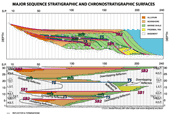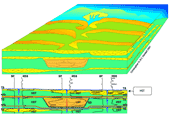|
early lowstand systems tract
falling stage systems tract
highstand systems tract
late lowstand systems tract
transgressive systems tract




|
The regressive systems tract was defined by Embry and Johannessen (1992). In his definition it lies above a transgressive systems tract and is overlain by the initial transgressive surface of the overlying transgressive systems tract. This complete sequence is know as a transgressive-regressive sequence (T-R sequence).

The sediments of this systems tract include the highstand system tract of Posamentier and Allen (1999), and the falling stage system tract defined by Plint and Nummedal, (2000) and/or the systems tract termed the early lowstand systems tract (ELST) (Posamentier and Allen, 1999).

References
Catuneanu, Octavian (2002), Sequence Stratigraphy of clastic systems: concepts, merits, and pitfalls Journal of African Earth Sciences, Volume 35, Issue 1, Pages 1-43
Christie-Blick, N., 1991, onlap, offlap, and the origin of UnConformity bounded depositional sequences. Marine Geology 97, 35–56.
Curray, J.R., 1964, transgressions and regressions. In: Miller, R.L. (Ed.), Papers in Marine Geology. Macmillan, New York, pp. 175– 203.
Embry, A.F., 1993, Transgressive–regressive (T–R) sequence analysis of the Jurassic succession of the Sverdrup basin, Canadian Arctic Archipelago. Canadian Journal of Earth Sciences 30, 301–320.
Embry, A.F., 1995, sequence boundaries and sequence hierarchies: problems and proposals. In: Steel, R.J., Felt, V.L., Johannessen, E.P., Mathieu, C. (Eds.), sequence stratigraphy on the Northwest European Margin, vol. 5 (Special Publication). Norwegian Petroleum Society (NPF), pp. 1–11.
Embry, A.F., Johannessen, E.P., 1992, T–R sequence stratigraphy, facies analysis and reservoir distribution in the uppermost Triassic- Lower Jurassic succession, western Sverdrup basin, Arctic Canada. In: Vorren, T.O., Bergsager, E., Dahl-Stamnes, O.A., Holter, E., Johansen, B., Lie, E., Lund, T.B. (Eds.), Arctic Geology and Petroleum Potential, vol. 2 (Special Publication). Norwegian Petroleum Society (NPF), pp. 121–146.
Galloway, W.E., 1989, Genetic stratigraphic sequences in basin analysis. I. Architecture and genesis of flooding-surface bounded depositional units. American Association of Petroleum Geologists Bulletin 73, 125–142.
Haq, B.U., Hardenbol, J., Vail, P.R., 1987, Chronology of fluctuating sea levels since the Triassic. Science 235, 1156–1166.
Hunt, D., Tucker, M.E., 1992, Stranded ParaSequences and the forced regressive wedge systems tract: deposition during base-level fall. Sedimentary Geology 81, 1–9.
Hunt, D., Tucker, M.E., 1995, Stranded ParaSequences and the forced regressive wedge systems tract: deposition during base-level fall––reply. Sedimentary Geology 95, 147–160.
Plint, A.G., Nummedal, D., 2000, The falling stage systems tract: recognition and importance in sequence stratigraphic analysis. In: Hunt, D., Gawthorpe, R.L. (Eds.), Sedimentary Response to forced regression, vol. 172. Geol. Soc. London Speci. Publ, pp. 1–17.
Posamentier, H.W., Allen, G.P., 1999. Siliciclastic sequence stratigraphy: concepts and applications. SEPM Concepts in Sedimentology and Paleontology no. 7, 210 p
Posamentier, H.W., Jervey, M.T., Vail, P.R., 1988, eustatic controls on clastic deposition. I. Conceptual framework. In: Wilgus, C.K., Hastings, B.S., Kendall, C.G.St.C., Posamentier, H.W., Ross, C.A., Van Wagoner, J.C. (Eds.), Sea Level Changes––An Integrated Approach, vol. 42. SEPM Special Publication, pp. 110– 124.
Posamentier, H.W., Vail, P.R., 1988, eustatic controls on clastic deposition. II. sequence and systems tract models. In: Wilgus, C.K., Hastings, B.S., Kendall, C.G.St.C., Posamentier, H.W., Ross, C.A., Van Wagoner, J.C. (Eds.), Sea Level Changes––An Integrated Approach, vol. 42. SEPM Special Publication, pp. 125– 154.
|